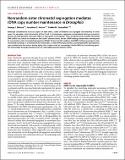Nonrandom sister chromatid segregation mediates rDNA copy number maintenance in Drosophila
Author(s)
Watase, George J; Nelson, Jonathan O; Yamashita, Yukiko M
DownloadPublished version (4.167Mb)
Publisher with Creative Commons License
Publisher with Creative Commons License
Creative Commons Attribution
Terms of use
Metadata
Show full item recordAbstract
<jats:p>
Although considered to be exact copies of each other, sister chromatids can segregate nonrandomly in some cases. For example, sister chromatids of the X and Y chromosomes segregate nonrandomly during asymmetric division of male germline stem cells (GSCs) in
<jats:italic>Drosophila melanogaster</jats:italic>
. Here, we demonstrate that the ribosomal DNA (rDNA) loci, which are located on the X and Y chromosomes, and an rDNA binding protein Indra are required for nonrandom sister chromatid segregation (NRSS). We provide the evidence that NRSS, following unequal sister chromatid exchange, is a mechanism by which GSCs recover rDNA copy number, counteracting the spontaneous copy number loss that occurs during aging. Our study reveals an unexpected role for NRSS in maintaining germline immortality through maintenance of a vulnerable genomic element, rDNA.
</jats:p>
Date issued
2022Department
Massachusetts Institute of Technology. Department of BiologyJournal
Science Advances
Publisher
American Association for the Advancement of Science (AAAS)
Citation
Watase, George J, Nelson, Jonathan O and Yamashita, Yukiko M. 2022. "Nonrandom sister chromatid segregation mediates rDNA copy number maintenance in Drosophila." Science Advances, 8 (30).
Version: Final published version